|
Tuesday, March 8
- Bagel sandwich
- Chicken and rice soup
- Italian sausage with peppers and onions
- *Beef stroganoff
- Chicken tetrazzini
- Cuban panini
- Assorted sliced pizza
- Shrimp pesto
Wilson Hall Cafe Menu
|
|
Wednesday, March 9
Lunch
- Stuffed flank steak
- Parmesan orzo
- Italian cream cake
Friday, March 11
Dinner
- Pasta carbonara
- stuffed filet of sole with crabmeat
- Sautéed spinach with lemon and garlic
- Pecan rum cake
Chez Leon Menu
Call x3524 to make your reservation.
|
|
Hands on science a hit with kids of all ages at Open House
On Sunday, Feb. 27, more than 1,500 people flocked to Fermilab to participate in the annual Fermilab Family Open House. This year’s event featured hourly cryogenics shows by Jerry Zimmerman as "Mr. Freeze," the popular Ask-a-Scientist session on the 15th floor of Wilson Hall and hands-on exhibits designed and built by area high school physics students. Photos from the event are below.
View the full gallery here.
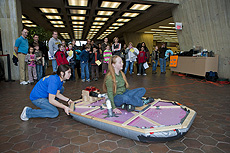 |
| Naperville North High School students designed a hover craft using a leaf blower to demonstrate force and motion.Photo: Cindy Arnold |
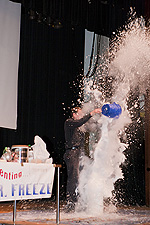 |
| Jerry Zimmerman’s cryogenics show, where he performs as Mr. Freeze, created explosions of soap bubbles and drew cheers. Photo: Cindy Arnold. |
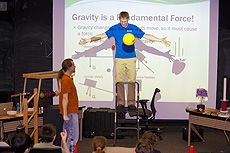 |
| DZero physicist Mike Cooke and neutrino physicist Dave Schmitz, both from Fermilab, perform the FUNdamentals of Physics show demonstrating how gravity affects a bowling ball and feather. Photo: Cindy Arnold. |
|
South Dakota School of Mines and Technology visits
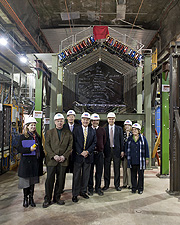 |
|
On Feb. 25, President Robert A. Wharton and Vice President for Research Affairs Ronald White from the South Dakota School of Mines and Technology visited Fermilab. Their tour included a visit underground to the MINOS cavern. Standing in front of the MINERvA detector are (left to right) Elizabeth Clements, Ronald White, Mike Weis, Robert Wharton, Rob Plunkett, Jim Strait, Katie Yurkewicz and Gina Rameika.
|
|
Beetle bags go up across site
 |
| USDA hang up beetle monitoring traps in Big Woods. Courtesy Rod Walton Photo: Courtesy Rod Walton. |
Field workers for the U.S. Department of Agriculture arrived at Fermilab recently to install one of four beetle monitoring traps. The USDA has used Fermilab as a trap site for the past three years. The traps allow researchers to keep track of population numbers and migration patterns for wood-boring and bark eating beetles. These types of insects feed on trees but do not destroy them the way emerald ash borer beetles do. Fermilab has hosted separate traps for emerald ash borer monitoring previously. The traps also serve as an early warning signal, alerting USDA researchers when a new species of beetle moves into the area.
|
Gravity's bias for left may be writ in the sky
From New Scientist, March 5, 2011
Is gravity left-handed? An answer could provide a clue to a long-sought theory of quantum gravity - and might be within our grasp by 2013.
General relativity describes gravity's actions at large scales. For tiny scales however, a theory of quantum gravity, incorporating quantum mechanics, is needed. But first physicists need to understand gravitons, hypothetical quantum particles that mediate the gravitational force. These likely come in left and right-handed varieties: in the former, the particle's spin would be aligned with the direction of its motion; in the latter, the spin would be the opposite.
General relativity does not distinguish between right and left, so you might expect gravity to be transmitted by both varieties. But the quantum world may play favourites. When it comes to the ghostly particles known as neutrinos, for example, the weak force only interacts with the left-handed variety.
To find out whether gravitons fall into the "ambidextrous" camp of general relativity or exhibit quantum asymmetry much like a neutrino, João Magueijo and Dionigi Benincasa of Imperial College London suggest looking to the cosmic microwave background, relic radiation from the big bang. During inflation, the faster-than-light expansion of the nascent universe, powerful gravitational waves may have rippled through space-time, polarising the CMB's photons in a telltale pattern.
Read more
|
|
Budget update
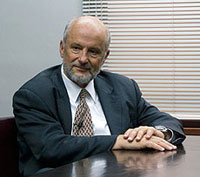 |
|
Fermilab Director Pier Oddone
|
As part of the DOE budget process, last week we presented the program of the laboratory to the Office of High Energy Physics (OHEP) under three budget scenarios for the fiscal years 2011 through 2015. The guidance for these scenarios came from OHEP. The lowest scenario was one in which the program was cut by 5 percent in FY2012 relative to the FY2010 enacted level and stayed flat, without inflation adjustments, through FY2015. The middle scenario was one where we essentially stayed flat from FY2010 through FY2015, without inflation adjustments. In the top scenario we were encouraged to ask for what we need to accomplish an optimal program by adding selectively to a limited set of initiatives. At the end of the day we will live in only one scenario, possibly not even one that we presented. However, each of the three scenarios is important. Together they describe where we would make cuts if we had to cut and where we would add funding should this become possible. These scenarios allow our program managers to propose and defend budgets for HEP in the context of the overall Office of Science.
Articulating clearly the program in high energy physics has never been more important. The President’s FY2012 Budget Request to Congress has made clear priority choices, with a strong emphasis on science that addresses issues in clean energy. That is not where we make our mark. At the same time the administration is supporting particle physics with a program that allows us to transition to new programs within a relatively flat budget profile. The Secretary of Energy, in his testimony to the House Committee on Science, Space and Technology, made it clear that the funding for particle physics can increase when we start building new, large facilities that now do not fit within a flat budget profile.
The scenarios we worked hard to understand could, of course, be thrown out the window if some of the present cuts proposed in Congress are applied. During the trip to Washington I spent a day visiting various Congressional offices. The picture that emerges is quite murky. The House bill that cuts 20 percent from the Office of Science in the current fiscal year will go to the Senate where it is likely to be defeated. The Senate has introduced its own bill cutting “only” 5 percent from the Office of Science. It is not even clear that such a bill will pass the Senate, never mind the House. At some point all of this should lead to an agreement by the House, the Senate and the Administration to tackle the deficit in a comprehensive manner. How that will play out, and what effects the various pressure points like a government shutdown or the need to raise the debt limit will have, are all up in the air.
One thing that is clear so far is the lack of understanding of the role of the Office of Science. Both in the House and the Senate bills, the Office of Science is cut significantly more than the NSF, NIH or NASA science programs. There is an immediate and acute need to explain that the Office of Science is an integral part of the scientific enterprise of our nation, provides the major scientific facilities, is the major supporter of the physical sciences and is no less important than the other major scientific agencies.
|
|
March 4-7
- Four stores provided ~41 hours of luminosity
- Store 8549 quenched due to a kicker problem
- A Switchyard septa tripped off due to a vacuum problem
- The Tevatron quenched during shot setup due to another kicker problem
- Linac and Operator personnel tuned up the I- Source
- DZero required eight-hour access for repairs
- Tevatron and Antiproton Source personnel conducted studies
- Due to ComEd work, Operations turned off the accelerator complex for machine upgrades and repairs
* The integrated luminosity for the period from Feb. 21- March 7 was 52.1 inverse picobarns. NuMI was off to replace its target.
Read the Current Accelerator Update
Read the Early Bird Report
View the Tevatron Luminosity Charts
|
|